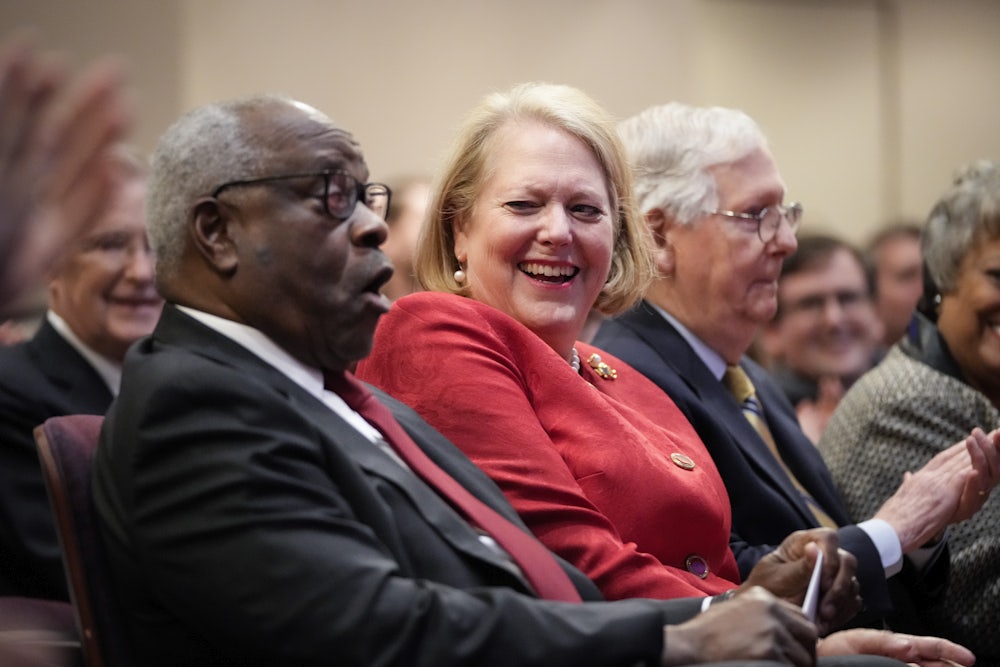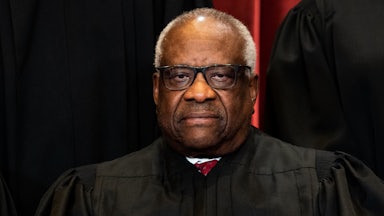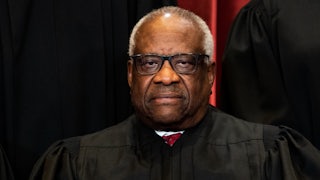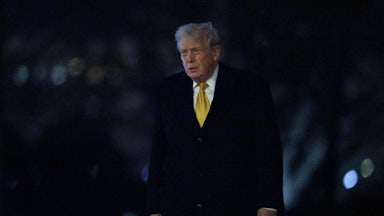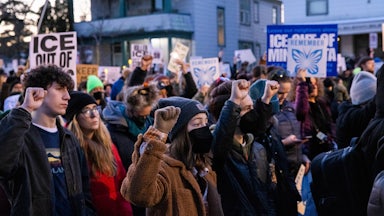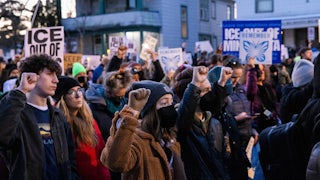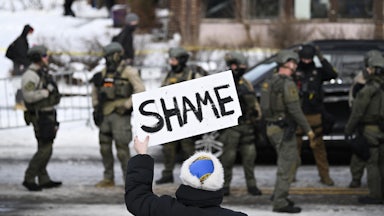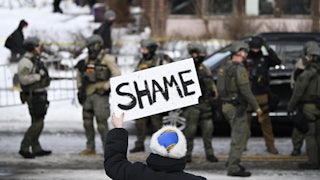The spouses of Supreme Court justices rarely, if ever, make news. They typically do not seek out the spotlight or comment on political issues. They do not usually engage in activities that could create conflicts of interest. Those who are lawyers themselves take jobs that keep them far away from the high court’s docket. Martin Ginsburg, a renowned tax attorney and the husband of Ruth Bader Ginsburg, became better known to the public toward the end of his life for his excellent cooking than for his legal career. Being married to a justice does not mean a monastic life, but it usually means a life lived within certain limits.
And then there is Ginni Thomas, the wife of Justice Clarence Thomas. To say that she is an outlier among the justices’ spouses is like saying that the full moon is an outlier in the night sky. Ginni Thomas is not just politically active; she is an outspoken activist with personal and professional ties in almost every corner of conservative politics. After years of tiptoeing up to the ethical lines, it is now clear that she will be a serious problem for the Supreme Court’s legitimacy and credibility for the foreseeable future.
The Washington Post reported on Thursday that Ginni Thomas texted with then–White House chief of staff Mark Meadows on multiple occasions about the 2020 election and the legal and political battles that followed it. In messages obtained by the House January 6 committee, she urged Meadows—and, by extension, the Trump White House—to fight harder to overturn the results of the 2020 election. “The majority knows Biden and the Left is attempting the greatest Heist of our History,” she wrote to Meadows on November 10, 2020, five days after the election.
The messages show how thoroughly Ginni Thomas has immersed herself in some of the most conspiratorial and extremist streams of right-wing thought. In a November 5, 2020, text to Meadows, she quoted a passage that had circulated in right-wing social media circles that praised extrajudicial punishments for their perceived enemies. “Biden crime family & ballot fraud co-conspirators (elected officials, bureaucrats, social media censorship mongers, fake stream media reporters, etc) are being arrested & detained for ballot fraud right now & over coming days, & will be living in barges off GITMO to face military tribunals for sedition,” the passage read.
In another text message, she sent a now-deleted YouTube video to Meadows that apparently claimed Trump and the U.S. military were carrying out a sting operation on election fraud against Democrats using watermarked ballots. (They were not.) The QAnon movement, which fantasizes about the violent and extrajudicial purge of Democratic and liberal elites, spread similar theories after the 2020 election. Ginni Thomas encouraged Meadows to put Sidney Powell, a conservative lawyer who spread false claims about the 2020 election, at the forefront of the Trump White House’s legal efforts. “Make a plan,” she wrote in one message. “Release the Kraken and save us from the left taking America down.”
Ginni Thomas has come under scrutiny before. In 2000, she worked for the Heritage Foundation to gather résumés for possible Bush administration appointees even as her husband took part in the Bush v. Gore litigation. She continued to enjoy close working ties with the Bush White House while her husband heard cases involving it. In 2018, the National Archives turned over tranches of Brett Kavanaugh’s White House emails to the Senate Judiciary Committee for his own Supreme Court confirmation process. Those who pored through Kavanaugh’s emails also had to wade through thousands (literally) of duplicate copies of Ginni Thomas’s Heritage Foundation newsletter to various Bush administration officials.
More recently, The New York Times and The New Yorker have dug extensively into her political work and how it might intersect with her husband’s job. By dint of her marriage, as well as her lobbying firm, Liberty Consulting, she is one of the most well-connected figures in the conservative movement. She is also a leader of the Groundswell coalition of pro-Trump figures that sought to wage a “30-front war” to “protect President Trump.” As part of those efforts, she personally encouraged the Trump White House to fire various officials who were perceived as disloyal to the president and to hire new officials in their place—vetted by her—who would be more suitable.
Much of Ginni Thomas’s activism came close to crossing ethical lines without explicitly breaching them. Her texts to Meadows are categorically different, both in their partisan and conspiratorial tenor and in their implications for her husband’s work. It is one thing for Ginni Thomas to engage in conservative activism on issues that might come before the court. While it’s always been unseemly for her to engage in partisan behavior, I’ve hesitated to write about it before because I saw no clear instances where she might have affected a specific case. It’s also not like Clarence Thomas needs his wife’s encouragement to take a deeply conservative approach to the law.
It is quite another thing, however, for Ginni Thomas to encourage the White House to overthrow an election based on fever-swamp conspiracy theories. Whatever ethical lines there are for the spouses of Supreme Court justices, I don’t think it’s too much to ask that they not try to destroy the republic. It was already known that Ginni Thomas had publicly encouraged the Stop the Steal rallies before they took place and that she had attended the fateful rally on the Ellipse where Trump encouraged his supporters to “fight like hell.” (She claimed she left before Trump spoke.) The Meadows texts make clear that she was not simply a bystander to events as they unfolded.
Her involvement now raises serious ethical concerns about Thomas’s own role in the post–Election Day litigation brought by Trump and his allies, especially now that we know she had encouraged the White House to embrace Sidney Powell and “release the Kraken.” More urgently, the Meadows texts make it ethically indefensible for Thomas to take part in any cases related to the January 6 investigations. Even if Ginni Thomas wasn’t a planner of or a participant in the insurrection, she is now a witness to those efforts. The Supreme Court has already considered one motion involving the House January 6 committee’s efforts to gather evidence from the Trump White House. In that dispute, Clarence Thomas was the only justice who publicly indicated that he would have sided with Trump’s efforts to block the committee from obtaining evidence.
Why is this the Supreme Court’s problem, as opposed to just the Thomases’ problem? Because there is no way for anyone else to fix it. A Supreme Court justice can only leave their position through resignation, impeachment, or death. So far, Clarence Thomas has shown no interest in retirement. In 1993, the Times reported that he had told associates that he planned to serve on the high court until 2034, which would give him a record 43-year tenure. “The liberals made my life miserable for 43 years, and I’m going to make their lives miserable for 43 years,” he reportedly said. Ginni Thomas, commenting to People magazine after his confirmation fight in 1991, also hinted at a partisan grudge. “Clarence will give everyone a fair day in court, but I feel he doesn’t owe any of the groups who opposed him anything,” she said.
For those same reasons, it is also impossible to imagine that he would resign over his wife’s behavior or in response to the political blowback from it. The Thomases clearly remain scarred by his confirmation hearing. “The intense pressures you and our President are now experiencing are more intense than Anything Experienced (but I only felt a fraction of it in 1991),” Ginni Thomas wrote to Meadows in one text message. They will likely interpret this scandal as yet another liberal plot to take them down and resist it accordingly. It is inconceivable that Thomas would willingly give Joe Biden, who presided over his confirmation hearing, the chance to nominate his successor.
Some on the left have floated impeaching Clarence Thomas. There are a few problems with this option. For one, it’s unclear at this point if the justice has actually committed an impeachable offense. There is no proof that he knew about his wife’s texts with Meadows, and the only person who could say otherwise is Ginni Thomas. And even a rock-solid impeachment case would only result in the justice’s acquittal. Only a handful of Republican senators voted to convict Donald Trump during his second impeachment trial, and Trump had actually incited a mob to attack a building while they were inside it. What Republican senator would vote to oust the leader of the court’s conservative wing and give Biden and a Democratic Senate the power to replace him?
That just leaves the status quo. For the other justices, this will be a bleeding ulcer. The House January 6 committee may yet uncover more conversations between Ginni Thomas and Trump White House officials. Meadows only provided some of his texts to the committee before ending his cooperation. Ginni Thomas also alluded to conversations she had with “Jared,” who is likely Jared Kushner, Trump’s son-in-law. The committee may also find itself in the position of calling her to testify as a witness. If it does and she fights the subpoena in court, the justices would eventually find themselves in the awkward position of ruling for or against one of their colleague’s spouses.
So what can be done? The Supreme Court is ultimately a body of equals. Unlike Congress, it cannot vote to censure or expel one of its own members. Unlike the executive branch, nobody has the power to hire or fire anyone else. All that constrains each of the justices is their own sense of honor and their commitment to the rule of law. And when one of them fails in that regard, all that the other justices can do is watch as it drags down the institution with them. The Thomases have put the Supreme Court in a terrible position and, unfortunately for everyone else, they are the only ones who can get the court out of it.
